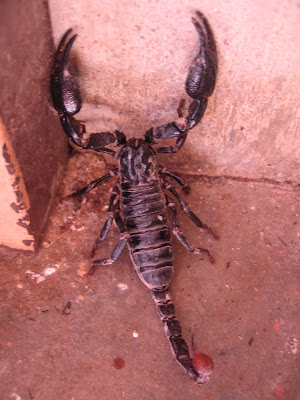

this scorpion was crawling on the cement floor just outside the main door of the house. scorpions are supposed to be nocturnal creatures; wonder why this one was wandering around in the day. using a metal rod and a scoop, i managed to catch the scorpion and put it in a pail from which it was unable to get out. you can see the poisonous sting at the end of its tail.
city dwellers hardly encounter scorpions; this is my third encounter with scorpions and it has always happened in broad daylight. the first time i came across a scorpion was when i was driving along the road leading to the upper peirce reservoir park. the second time it happened when i was walking near the tree-top walk. the previous two scorpions were not as big as this one.
scorpions are easily distinguished by their long sting-bearing tail and a pair of pincers on long arms, known as pedipalps, at the front of the body. despite having six to twelve eyes - an obvious pair at the centre of the carapace and two to five smaller eyes on each side -
scorpions do not have good eyesight. however, they can readily distinguish light from dark and appear to have excellent low light sensitivity, which helps them to both avoid harsh sunlight and to navigate by starlight or moonlight. they sense their way around using sensory hairs and slit organs on the legs, pedipalps and body that pick up vibrations and scents. they also have special organs on the underside of the body called pectines, which pick up ground textures and scents. scorpions breathe through four pairs of book lungs on the underside of the abdomen.
female scorpions are more heavily built than males, with shorter tails. colour ranges from dark grey to light brown or gold, with lighter coloured legs. scorpions also fluoresce under ultraviolet light, which is a good way for scientists to find them in the field. the fluorescence is thought to serve as an ultraviolet sensitivity mechanism, perhaps allowing the scorpion to avoid damaging light levels.
scorpions are nocturnal hunters, feeding mainly on arthropods such as beetles, cockroaches, spiders, slaters, centipedes and millipedes. one species, isometroides vescus, is specialised to feed solely on burrowing spiders, especially trapdoor spiders, invading and often occupying their burrows. many scorpions are lie-in-wait ambushers that forage at or in the vicinity of the burrow entrance, but some, notably bark and litter dwellers , are more active foragers.






3 comments:
Wa! you very brave ... finger crushed not healed yet and then you went to disturb poisonous scorpion, haha.
fr, things did not happen in the order they appeared on the blog. i had caught the scorpion two days prior to my finger being caught.
anyway, i had the aid of a metal rod and a plastic scoop to capture the scorpion.
Post a Comment